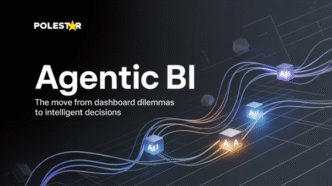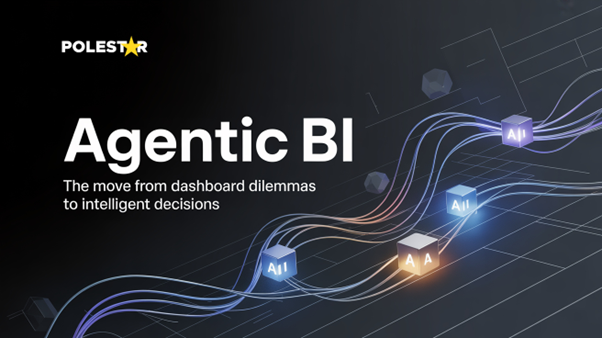Unlike conventional BI tools that wait for queries, Agentic Business Intelligence (BI) represents a fundamental shift in how organizations interact with data. Recent innovations like Databricks AI/BI Genie have introduced conversational interfaces that respond intelligently to natural language prompts—making data analysis more accessible—Agentic BI can take this several steps further. It can constantly monitor data streams, track complex objectives across manifold systems, and learn from outcomes to refine its approach. This rudimentary shift changes how enterprises extract value from information, moving from query-response models to autonomous intelligence.
The dashboard challenges holding enterprises
Here’s a situation for every business user – They look at the dashboards, but their real questions remained unanswered like – why did sales drop last Friday? Which customer segments are churning faster? The dashboard shows what happened—not why or what to do next.
Quite frankly, many business users had to wait for days for responses to complex queries from the data team. By then, insight becomes obsolete. Self-service BI promised independence but delivered challenges—leaving non-tech users bound between inadequate tools and overwhelmed data teams.
Agentic BI dissolves this bottleneck. Ask your question in plain English, and the system doesn’t just return a chart—it investigates, explains causality, suggests actions, and can even execute them.
Why Agentic BI matters?
According to IBM, 68% of enterprise data is never analysed—not because it lacks value, but because analysis requires too much manual effort. Traditional BI creates a dangerous gap: the space between knowing and doing. And this lag surfaces problems for organizations where-
- Pre-built models answer only anticipated questions. Organizations get outdated, inconsistent insights that can’t adapt to changing business needs.
- Users wait weeks for BI teams to build reports. Insights arrive too late, opportunities disappear while requests queue up endlessly.
- Hundreds of conflicting dashboards across teams. Users can’t find the right data, so they export to Excel anyway wasting the investment.
With Agentic AI systems, businesses can easily squeeze the insight-to-action timeline from days to minutes. It forecasts what you require to know, surfaces insights proactively, and initiates suggestions without human interventions, leading to quick decisions, consistent policies, and lesser costly errors.
What Makes Agentic BI Different- Explore some of its core capabilities
Most “intelligent” tools still wait for humans to ask the right questions at the right time. Agentic BI doesn’t wait.
Autonomous Investigation: AI agents query across APIs, SQL databases, CRM systems, and unstructured docs without the need of data engineering work.
Context-Aware Intelligence: The system grasp what matters to every role. Finance receives early-warning alerts on cash flow anomalies. Marketing gets Slack digests when campaign performance deviates from projections. Sales managers see deal risk scores that update in real-time.
Embedded Workflow Integration: Insights don’t live in a separate BI portal. They appear in Teams, Slack, Salesforce, or wherever decisions are taken— accelerating response times and eradicating context switching.
Constant Learning: Unlike traditional dashboards, agentic systems improve with utilization. A fraud detection agent analyzing transaction patterns becomes more apt over time, diminishing false positives by learning from each case flagged as distrustful.
Proactive Monitoring: Instead of relying on someone to check dashboard, agents constantly monitor KPIs and automatically identify anomalies before it comes to humans notice that something’s wrong.
Some practical examples of Agentic BI across departments
The below examples will show the breadth of what’s possible and how the system learns and responds more intelligently with each interaction.
Scenario 1: Sales Leadership: Fast, Targeted Pipeline Analysis
Let’s understand this, a sales VP leverages Agentic BI to analyse performance instantly. Rather than navigating spreadsheets and dashboards, he simply asks, “How did revenue in the West region change last quarter?” within seconds, the system reports a 7% increase and pinpoints underperforming stores. He goes a bit deeper – “check inventory in store #35- and discover stockout as the cause. So, what once took hours of manual analysis, now happens conversationally, enabling sharper and faster decisions.
Scenario 2: Marketing Campaign Optimization
Consider a Marketing expert using agentic BI to grasp why Q3 campaigns not performed compared to Q2. He asks, “How did our Q3 campaigns perform versus Q2?”, the system replies – “Conversions were dipping by 10%, mainly in email campaigns.” With few follow-up questions, the marketing expert came to know that morning send times drive higher engagement. So, instead of wrangling through spreadsheets or tools, he rapidly identifies and act on data-driven insights to optimize future campaigns.
How businesses can adopt Agentic BI today: Some tips
Replace manual workflows: Run through proper audit where your team invests time curating reports rather than analyzing them. These are some prime priorities for agent-powered automation.
Begin with high-frequency quests: Figure out 5-10 questions your executives/teams ask more frequently. Configure agents to monitor these continuously rather than generating weekly static reports.
Embed where work happens: Integrate P.AI into existing workflows to deliver insights directly into Slack, Teams, and daily tools—turning conversations into actionable intelligence.
Enable self-service with guardrails: Allow business users to ask questions directly but take action thresholds to maintain control and apply governance on data access.
Parting thoughts
Agentic BI represents a fundamental shift: from descriptive analytics to autonomous decision support. The technology exists today—platforms are already embedding these capabilities into workflows.
At Polestar Analytics, we see this evolution as the next natural step in enterprise intelligence. The question isn’t whether agentic systems will replace traditional dashboards. It’s whether your enterprise will adopt them before competitors do. Because in markets where timing determines outputs, the benefit goes to those who turn data into action quickly.














